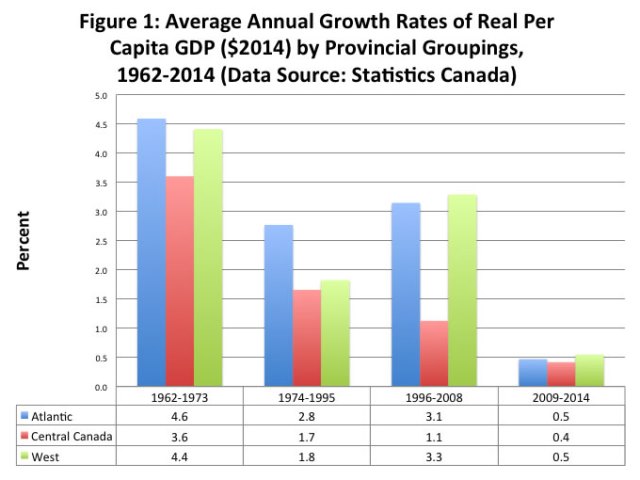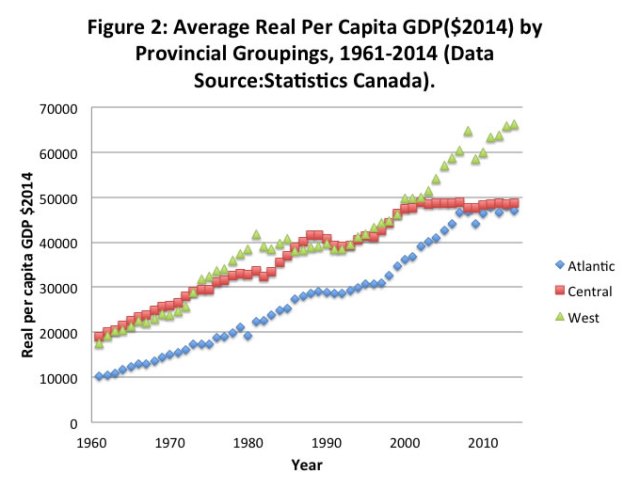The long decline of Ontario and Quebec
When one thinks of ranking recent economic performance of Canadian regions, the malaise in Central Canada’s manufacturing and the Western resource boom and collapse spring to mind. Yet, when a longer-term view encompassing the last half-century is taken, it becomes apparent that Central Canada in particular—Ontario and Quebec—has been afflicted by what can only be termed a decline in economic performance that long predates the 2009 recession.
The annual average growth rate of real per capita GDP over the period 1962 to 2014 was three per cent across the four Atlantic provinces, compared to 2.6 per cent for the four Western Canadian provinces and only a meager 1.8 per cent for the two Central Canadian provinces of Ontario and Quebec. The real per capita growth performance of the Atlantic region is buoyed by fact that the region has had some of the lowest population growth rates in the country. Over the period 1962 to 2014, the average annual growth rate of population in the Atlantic Canadian provinces was 0.4 per cent while in Central Canada it was 1.2 per cent and in the West 1.6 per cent. Notably, both the Atlantic and West are more resource intensive than Central Canada.
Nevertheless, when the growth rates are broken up by both time period and region it becomes apparent that Ontario and Quebec together exhibit the most pronounced performance decline. The chart below plots average annual provincial real per capita GDP growth rates by region for select periods from 1962 to 2014. The time periods correspond to the pre 1973 period of robust growth, the period of stagflation, recession and fiscal crisis from 1974 to 1995, the recovery and boom era of 1996 to 2008 and the post 2009 recession. It’s not a pretty picture for Ontario and Quebec. Along with the lowest growth rate overall from 1962 to 2014, the average growth rate in Central Canada has also been below each of the other two regions in each of these selected time periods. At an average of 3.6 per cent, the most robust growth period for Central Canada was during the pre-1973 oil crisis. It has been downhill since.

The stagflation, recessionary and fiscal crisis era from 1974 to 1996 saw Central Canada’s real per capita GDP grow at 1.7 per cent versus 2.8 for Atlantic Canada and 1.8 for the West. The recovery and boom era from 1996 to 2008 had Central Canada’s growth rate fall further to 1.1 per cent compared to 3.1 for Atlantic Canada and 3.3 for the West. Finally, the post 2009 period—the era of the Great Recession sees all regions hit by poor average real per capita GDP growth but Central Canada is the lowest of the lot falling to 0.4 per cent.
The long-term result of slower growth is demonstrated in the second chart below. Average real per capita GDP in Atlantic Canada now practically matches that of Central Canada. Central Canada’s real per capita GDP was surpassed by the west in the 1970s and nearly met by Atlantic Canada in 2008. Real per capita GDP in Central Canada has essentially been flat since approximately the turn of the 21st century. Moreover, the Atlantic Canadian growth spurt also came to a halt starting with the onset of the 2009 recession.

Over the last 50 years, Canada has evolved into two distinct economic regions when it comes to real per capita GDP with higher per capita incomes west of Ontario. While global economic factors are factors in this evolution, one must also add the effect of poor government economic policy—especially in Central Canada—that slowed economic growth. Among the poor policy choices that characterized these 50 years are uncompetitive tax structures, bigger government and growing government regulation of activity. However, the greatest legacy of government policy in Ontario and Quebec has been the acquisition of the largest provincial government debts in the country—both absolute and per capita.
Adam Smith noted that deficit financing gradually enfeebled every state that has adopted it and that bankruptcy is always the end of great accumulations of debt. Need we say more?
Author:
Subscribe to the Fraser Institute
Get the latest news from the Fraser Institute on the latest research studies, news and events.

